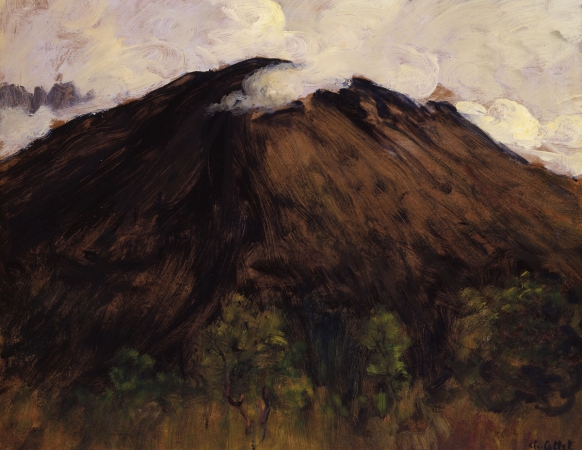COTTET, Mountain

Charles COTTET (1863-1925)
Mountain
ca. 1900-1910
oil on board
53 x 74 cm
© MuMa Le Havre / Florian Kleinefenn
Mountain
ca. 1900-1910
oil on board
53 x 74 cm
© MuMa Le Havre / Florian Kleinefenn
HD image
Between 1900 and 1910, years during which he enjoyed international acclaim, Charles Cottet sojourned regularly in Savoie. By the shores of Lake Geneva, in the area around the village of Féternes, he captured the nearby peaks of the Jura Mountains and the Alps beneath skies that were often full of contrast. These artworks were painted very spontaneously. In Mountain, which could represent the Hermones, above Thonon-les-Bains, Cottet proceeds almost instinctively, liberally using his brush to spread the highly fluid paint.
Mountain from the Senn collection is thus constructed hastily. The spontaneity and speed of execution further strengthen the upsurging of the mountain, crowned with unctuous mists pierced by the light. Their fluidity and motion are given a very modern rendering: by reserving certain areas of his board's surface, the artist manages to create darker patches that lend depth to the sky. He uses the same process on the sides of the mountain to vary his tones of black and mould the huge rocky mass. This very modern technique, fully mastered by Cottet, which developed the Impressionists' freedom of brushwork and heralded the artistic style of the Fauves, may have been influenced by Toulouse-Lautrec's practice of peinture à l'essence, or painting with solvent. He used it to depict the plateau from which he painted Lake Geneva and the Jura Mountains Viewed from Féternes (Orléans, Musée des Beaux-Arts) and Fog in Savoie (Tokyo, National Museum of Western Art, Matsukata collection).
The piece in Tokyo maintains close ties with the painting from the Senn collection. In it, the artist contrasts the dark and dramatic mountain mass with its slopes lapped by shifting swathes of mist. The success of these contrasts, which carried a certain idea of the romantic landscape into the turn of the century, earned repeated praise from his admirer Bénédite, then curator of the Musée du Luxembourg: "We have thus seen [...] [renewed] in the beloved Savoyard landscape and its snow, mist, clouds and storms, all the life and drama of the mountain weather portrayed with a unique vision."
Mountain from the Senn collection is thus constructed hastily. The spontaneity and speed of execution further strengthen the upsurging of the mountain, crowned with unctuous mists pierced by the light. Their fluidity and motion are given a very modern rendering: by reserving certain areas of his board's surface, the artist manages to create darker patches that lend depth to the sky. He uses the same process on the sides of the mountain to vary his tones of black and mould the huge rocky mass. This very modern technique, fully mastered by Cottet, which developed the Impressionists' freedom of brushwork and heralded the artistic style of the Fauves, may have been influenced by Toulouse-Lautrec's practice of peinture à l'essence, or painting with solvent. He used it to depict the plateau from which he painted Lake Geneva and the Jura Mountains Viewed from Féternes (Orléans, Musée des Beaux-Arts) and Fog in Savoie (Tokyo, National Museum of Western Art, Matsukata collection).
The piece in Tokyo maintains close ties with the painting from the Senn collection. In it, the artist contrasts the dark and dramatic mountain mass with its slopes lapped by shifting swathes of mist. The success of these contrasts, which carried a certain idea of the romantic landscape into the turn of the century, earned repeated praise from his admirer Bénédite, then curator of the Musée du Luxembourg: "We have thus seen [...] [renewed] in the beloved Savoyard landscape and its snow, mist, clouds and storms, all the life and drama of the mountain weather portrayed with a unique vision."
















